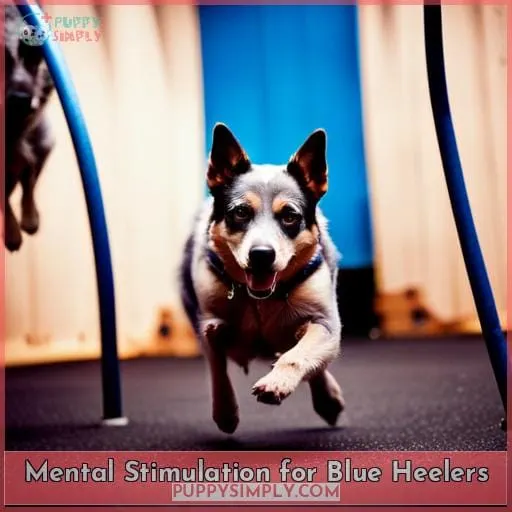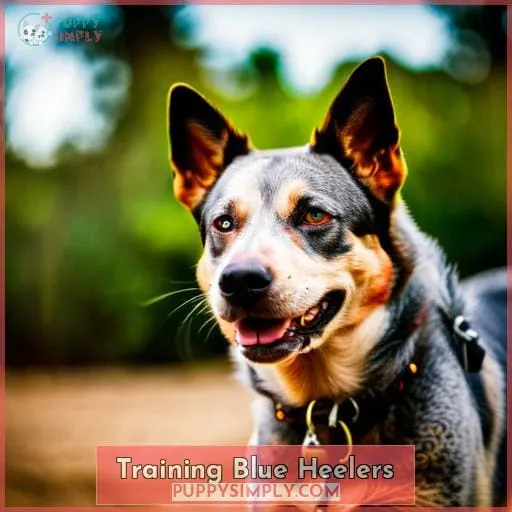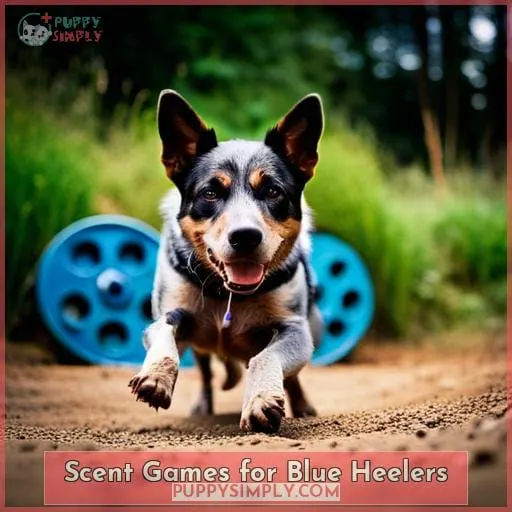This site is supported by our readers. We may earn a commission, at no cost to you, if you purchase through links.
 You adore your Blue Heeler’s loyalty, but you wrestle with their hyper energy.
You adore your Blue Heeler’s loyalty, but you wrestle with their hyper energy.
Understanding your energetic breed’s needs for stimulation is key to harmony.
Expert insights on nature versus nurture equip you to:
- Curb restlessness
- Channel liveliness through engaging activities
- Meet their needs for exercise and mental stimulation
Fulfill your loyal companion’s potential for focus and partnership.
Table Of Contents
- Key Takeaways
- Are Blue Heelers Hyper Dogs?
- Why Are Blue Heelers So Hyper?
- Do Blue Heelers Ever Calm Down?
- How Much Exercise Do Blue Heelers Need?
- Mental Stimulation for Blue Heelers
- Training Blue Heelers
- Scent Games for Blue Heelers
- Calming Techniques for Blue Heelers
- When Do Blue Heelers Become Calmer?
- Comparison to Similar Breeds
- Frequently Asked Questions (FAQs)
- Conclusion
Key Takeaways
- Blue Heelers are known for their boundless energy and hyperactivity, driven by their herding instincts and working needs.
- Hyperactivity in Blue Heelers can be caused by boredom, lack of stimulation, pent-up energy, insufficient mental exercise, and unfulfilled working needs.
- Calming techniques for Blue Heelers include providing a quiet space, offering calming treats, engaging in relaxing activities, maintaining a calm demeanor, and giving them a timeout in their crate.
- Mental stimulation for Blue Heelers can be provided through interactive toys, agility exercises, puzzle games, nose work, and scent games.
Are Blue Heelers Hyper Dogs?
Blue Heelers, known for their boundless energy and hyperactivity, are a handful. These playful puppies are a bundle of joy, but their intense energy levels can be overwhelming if not properly managed.
Their herding instincts drive them to constantly be on the move, making them prone to hyperactivity and destructive behaviors if not given an outlet for their energy.
Blue Heelers thrive on outdoor activities and interactive toys that challenge their minds and bodies. They excel in agility, herding, and obedience competitions, and they love exploring new places and engaging in interactive games.
Training is essential for Blue Heelers, as it helps them learn impulse control and channel their energy into positive behaviors. Additionally, providing them with relaxation techniques, such as massage or calming music, can help them wind down and relax when needed.
Understanding their unique needs and providing them with the right amount of exercise, mental stimulation, and training can help you create a harmonious relationship with your Blue Heeler.
By addressing their hyperactivity and providing them with the tools they need to thrive, you can transform your hyperactive Blue Heeler into a calm and well-behaved companion.
Why Are Blue Heelers So Hyper?
Common causes of hyperactivity in Blue Heelers include:
- Boredom
- Lack of stimulation
- Pent-up energy
Hyperactivity and overexcitement indicate an unhappy and stressed dog, even for typically high-energy breeds that can be calm when required.
Providing sufficient physical and mental exercise for a Blue Heeler is key to avoiding destructive behaviors resulting from pent-up energy.
Boredom
- When your Blue Heeler lacks mental and physical stimulation, they are prone to boredom and overactivity.
Keep your pup engaged with:
- Interactive toys
- Puzzle games
- Outdoor activities
Incorporate training sessions into their routine for mental challenges.
Lack of Stimulation
Insufficiently stimulating their sharp minds will just as frequently cause hyperactivity in Blue Heelers.
Engaging this intelligent breed in enrichment activities like interactive toys, outdoor adventures, canine puzzles, training games, and scenting challenges provides necessary mental stimulation.
Without enough mental exercise, Australian Cattle Dogs easily become overexcited.
Fulfilling the working needs of this herding dog prevents problematic lack of stimulation.
Pent-Up Energy
When pent-up energy’s causing your Blue Heeler’s hyperactivity, it’s time to amp up their exercise and engagement.
Interactive Toys:
Engage their intelligence with interactive toys that challenge and reward.
Outdoor Activities:
Unleash their energy with outdoor activities like fetch, frisbee, and agility.
Training Games:
Dedicate time to training games that stimulate their minds and reinforce good behavior.
Do Blue Heelers Ever Calm Down?
Blue Heelers do calm down as they mature, typically around 4 to 6 years old.
Consistency in training and providing sufficient exercise and stimulation from a young age are keys to promoting calmness.
Use positive reinforcement training methods and provide daily mental enrichment activities to engage their active minds.
Without proper training and stimulation, Blue Heelers may exhibit challenging behaviors like excessive barking, digging, and hyperactivity.
Make sure to meet their high exercise needs with at least an hour of intensive activity daily.
Additionally, incorporate mental exercises through training sessions and games.
Try gentle calming techniques like massage, gentle belly rubs, and light brushing to soothe an overexcited Heeler.
With time, training, and the right care, Blue Heelers transition from excitable pups to more mellow, obedient companions.
How Much Exercise Do Blue Heelers Need?
You’ll need to provide at least one hour of intensive physical work daily, preferably two hours, for an adult Blue Heeler.
Don’t think of it as a chore; rather, view it as your chance to forge an unbreakable bond with your canine companion.
Together, you can embark on invigorating adventures that won’t only keep your Blue Heeler physically fit but also mentally stimulated.
Embrace Outdoor Activities:
- Take your Blue Heeler on invigorating hikes.
- Engage them in exhilarating games of fetch.
-
Let them chase a frisbee in a wide-open field.
Establish Playtime Routines:
- Create a structured playtime routine.
- Incorporate a variety of mentally stimulating activities.
-
Interactive toys, agility courses, and puzzle feeders are excellent ways to engage your Blue Heeler’s sharp mind and prevent boredom.
Incorporate Canine Enrichment:
- Provide your Blue Heeler with opportunities for mental enrichment.
- Hide treats around the house or yard for them to find.
-
This will stimulate their natural foraging instincts and keep them occupied for hours.
Challenge Them with Exercise:
- Challenge your Blue Heeler with physically and mentally demanding exercise.
- Consider activities like swimming, jogging, or bikejoring.
- These activities will push your dog’s limits and provide them with a sense of accomplishment.
Mental Stimulation for Blue Heelers
Now that you’ve committed to providing ample physical exercise for your Blue Heeler, it’s time to delve into the equally crucial aspect of mental stimulation.
These whip-smart dogs crave intellectual challenges to stay balanced and content. Their dingo lineage and inherent herding instincts have instilled in them a thirst for problem-solving and strategic thinking.
Interactive toys are a fantastic starting point. Puzzle feeders, treat-dispensing balls, and chew toys that hide treats engage their minds and keep them occupied. You can also introduce puzzle games specifically designed for dogs. These games often involve hiding treats or toys in various compartments, challenging your Blue Heeler to use its intelligence and problem-solving skills to retrieve them.
Training challenges are another excellent way to stimulate your Blue Heeler mentally. Teach them new tricks, practice obedience commands, or enroll them in agility classes. These activities not only strengthen your bond but also provide much-needed mental exercise.
Don’t forget about nose work. Blue Heelers have exceptional scenting abilities, making them natural candidates for this engaging activity. Hide treats or toys around your home or yard and encourage your dog to find them using its keen sense of smell.
You can also sign up for formal nose work classes or competitions to further develop this innate talent.
Incorporating canine enrichment activities into your Blue Heeler’s routine is essential for their overall well-being. These activities can range from simple games like fetch or tug-of-war to more complex treasure hunts or obstacle courses.
The key is to keep things interesting and varied to prevent boredom and maintain their active minds engaged.
Training Blue Heelers
To train your Blue Heeler effectively, you’ll need to:
- Establish clear rules, boundaries, and routines.
- Maintain consistency and patience.
- Use obedience training to teach basic commands and reinforce good behavior.
Engage your Heeler’s mind through:
- Interactive toys.
- Agility exercises.
- Other mental challenges that tap into their intelligence.
- Rotate different activities to prevent boredom.
Practice relaxation techniques like go to mat to teach settling behaviors.
Incorporate both physical and mental stimulation into a training regimen customized to your Heeler’s specific needs.
A well-trained Heeler that gets proper stimulation will be a calm, happy, and loyal companion.
Scent Games for Blue Heelers
Since Australian Cattle Dogs have such keen senses of smell, you can engage them in scent games that provide mental stimulation while also burning some physical energy. These games not only entertain your Blue Heeler but also strengthen your bond and help them learn to focus.
- Hide and Seek: This classic game is a great way to get your dog moving and using their nose. Hide treats or toys around the house or yard and let your dog find them.
- Canine Puzzles: Interactive puzzle toys that dispense treats when your dog solves them are a fantastic way to challenge their minds and keep them entertained.
- Tracking Fun: Create a scent trail using treats or scented toys and let your dog follow it. This game is an excellent way to engage their natural tracking instincts.
- Nose Work: Enroll your Blue Heeler in nose work classes or set up your own scent detection course at home. Nose work is a stimulating activity that taps into their innate abilities.
- Smell Games: Play games that involve identifying different scents. You can use essential oils, herbs, or even food items to create a variety of scents for your dog to identify.
Calming Techniques for Blue Heelers
You’ll want to try various techniques to calm an overexcited Blue Heeler:
- Provide a quiet space.
- Offer calming treats.
- Engage in relaxing activities like brushing or gentle massage.
To calm an energetic Blue Heeler that’s getting out of control:
- Maintain a calm demeanor yourself to avoid agitating them further.
- Give them a timeout in their crate.
- Engage them in a focused training session.
If your Blue Heeler is overly hyper:
- Don’t yell or punish them.
- Use positive reinforcement by redirecting their energy into a calming activity like a food puzzle toy or a long-lasting chew.
A riled up Blue Heeler needs you to:
- Stay composed and not feed into their frenzy.
- Gently guide them into a settled state with calming music, massage, or TTouch bodywork.
| Technique | Benefit |
|---|---|
| Training Games | Focuses their energy and intelligence |
| Outdoor Activities | Expends pent-up energy in a positive way |
| Mental Exercises | Stimulates their active minds |
| Relaxation Techniques | Promotes calmness and relaxation |
| Interactive Toys | Provides mental and physical stimulation |
Don’t let a hyper Blue Heeler spiral out of control:
- Stay cool yourself.
- Redirect their energy by having them focus on you during an obedience training session or settling on a mat for a food reward.
When Do Blue Heelers Become Calmer?
The Australian Cattle Dog will typically start to calm down between ages 4 and 6 when their energy levels begin naturally decreasing.
As they transition into adulthood, consistency with training and ensuring they have positive outlets for exercise can continue nurturing this calm demeanor.
Training and exercise go hand in hand when it comes to managing a Blue Heeler’s energy.
Consistent training provides mental stimulation and teaches them appropriate behaviors, while exercise helps burn off excess energy and promotes relaxation.
Additionally, incorporating mental development activities such as puzzle toys and scent games can further tire your Blue Heeler and contribute to their overall calmness.
Along with aging effects, training impact, exercise benefits, and mental development, lifestyle adjustments can also play a role in calming a Blue Heeler.
Providing a structured routine, establishing clear boundaries, and creating a calm and stress-free home environment can help your dog feel more secure and less likely to exhibit hyperactive behaviors.
Comparison to Similar Breeds
Now, let’s put Blue Heelers under the microscope compared to other breeds.
You’ll find that they share similarities with other energetic companions, but they also stand out in their own right.
Starting with the Australian Shepherd, you’ll notice a striking resemblance in their boundless energy and devotion to their human companions.
Both breeds thrive on mental stimulation and physical activity, making them ideal partners for active owners who appreciate a dog that’s always up for an adventure.
If you’re seeking a breed with a strong work ethic, look no further than the Border Collie.
These intelligent canines excel in various dog sports, from agility to herding.
Like Blue Heelers, they require ample exercise and mental stimulation to channel their boundless energy positively.
Now, let’s talk about intelligence levels.
Blue Heelers, Australian Shepherds, and Border Collies consistently rank among the most intelligent dog breeds.
This remarkable intelligence makes them highly trainable, but it also means they need consistent mental challenges to stay engaged and prevent boredom.
Finally, let’s address exercise requirements.
All three breeds have high energy levels and require significant daily exercise to stay happy and healthy.
Blue Heelers typically need at least an hour of intensive physical activity each day, while Australian Shepherds and Border Collies may require even more.
If you’re considering one of these breeds, be prepared to provide ample opportunities for exercise and playtime.
Frequently Asked Questions (FAQs)
What health issues are common in Blue Heelers?
To maintain their well-being, Blue Heelers need routine checkups and screenings for common health issues:
- Hip dysplasia
- Elbow dysplasia
- Deafness
- Eye problems
How well do Blue Heelers get along with other pets?
Generally, Blue Heelers get along well with other pets if properly socialized from a young age.
Their herding instincts can cause them to try herding cats and small dogs, so supervision is advised.
Proper socialization and training help them accept the other pets in your home as part of their pack.
Are Blue Heelers good family dogs?
Hyper? Oh no! Blue Heelers are the sweetest family dogs around.
Like fluffy clouds of joy and laughter floating through your home, their boundless energy makes them the perfect playmate for kids and the best buddy for adults.
They’ll shower your family with unconditional love.
How much grooming and shedding can I expect from a Blue Heeler?
You can expect moderate shedding and weekly brushing from a Blue Heeler.
Their short, dense double coat will shed more during seasonal changes.
Regular brushing helps control loose hair and promotes a healthy coat for your energetic herder.
What kind of toys and chews do Blue Heelers like best?
Blue Heelers are smart and energetic dogs who love to chew.
Provide them with durable toys like Nylabones and Kongs.
Also provide interactive toys that challenge their minds.
Conclusion
Your Blue Heeler, a furry whirlwind of energy, craves stimulation like a parched land thirsts for rain.
To unlock their focus and partnership potential, you must understand their hyperactivity.
Unleash their boundless spirit through exercise, mental challenges, and training.
As you journey together, you’ll discover a harmonious balance between their innate liveliness and your serene sanctuary.
Blue Heelers, when nurtured correctly, transform into devoted, composed partners, their loyalty shining brighter than the sun after a storm.
















